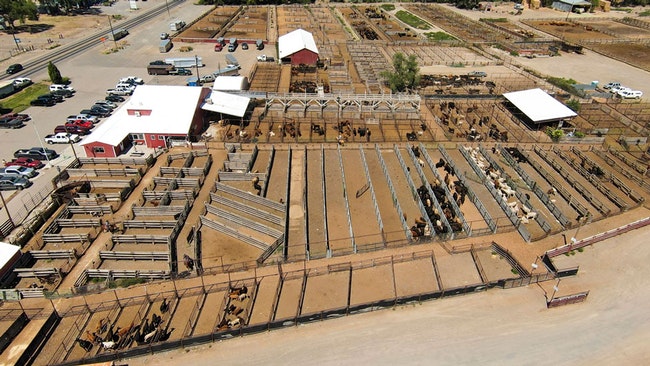
Beef sales jumped recently at Producers Livestock Marketing in Vale as drought conditions prompted some ranchers to sell their cattle earlier than normal. (The Enterprise/AUSTIN JOHNSON).
VALE – High temperatures and a lingering drought are pushing some area ranchers to sell their stock earlier than usual because vast stretches of rangeland are parched.
“Our sales have been running kind of two or three times bigger than normal,” said Jason Johnson, Producers Livestock Marketing branch manager in Vale.
Johnson said he believes the larger sales “has a lot to do with cattle coming off the range because it’s so dry and hot.”
“There is nothing to eat out there and the cost of hay is prohibitive,” said Johnson.
According to 2020 statistics from the Oregon Department of Agriculture there are about 75,000 beef cattle in Malheur County.
Malheur County earned a drought declaration from the state earlier this summer and area reservoirs are drying up fast.
Last week, Beulah Reservoir was 6% full while Warm Springs Reservoir was 4% full.
Owyhee Reservoir was 23% full and Bully Creek Reservoir stood at 26% full.
Johnson said the short-term situation for ranchers isn’t good as they sell off cattle earlier than normal. Long-term, he said, the outlook for beef ranchers is brighter.
“If you look at it on face value, our inventory, our cow herds, over the next couple of years will have fewer calves going into the feeding cycle and less beef produced. So, when you get less supply, if demand stays good, our product will have a little more value,” said Johnson.
Wannie Mackenzie, who owns ranches in Baker and Malheur counties, said the ongoing drought created new challenges for his operation, including moving some feeder cattle off the range two months earlier than normal.
“We’ve pulled 250 off (the range) and normally we don’t do anything until November and we are looking at September to start bringing cattle in. We are also weening earlier,” said Mackenzie.
Mackenzie said shifting cattle off the range back to a ranch means the consumption of hay climbs.
Mackenzie said he projects many ranchers will sell anywhere from 15% to 20% of their herd in the fall. That’s because, he said, the drought also impacted the hay crop in eastern Oregon.
“You are going to look at this and take all of them lower producing cows, cows you’d normally keep and sell them just to save on your hay,” said Mackenzie.
He agreed with Johnson on the long-term impact of fewer cattle.
“Next year it will be good because we will have anywhere from 15% to 20% less calves for the feedlot to buy,” he said.
That means, he said, sale prices should climb because of demand.
Across the U.S. beef prices are on the upswing, according to the National Cattlemen’s Beef Association. Wholesale and consumer demand for beef is at a 30-year high, according to the association.
Mackenzie said the long stretches of blistering heat didn’t impact his herds as much as he expected.
“All and all, I thought the cattle would have a harder time dealing with the heat than they have,” he said.
Still, the heat will influence some aspects of his operations.
“Our weights will be lighter. But our calves are healthy and I am very impressed with how they’ve done,” said Mackenzie.
Arock rancher Elias Eiguren said he hasn’t yet had to move large numbers of stock off the range. He said, though, the dry conditions will mean cattle will be moved off of range about two weeks earlier than usual.
Feeding the cattle once they are back on the ranch isn’t as major a challenge as it could be this year, said Eiguren.
“Even though we ran out of water earlier, we had a fairly decent hay crop for Arock,” he said.
Eiguren and Mackenzie said this year is unusually arid.
“I don’t know how it could be any drier,” said Eiguren.
Eiguren said irrigation water in Arock was cut off a month ago. At Mackenzie’s ranch in Jordan Valley, the irrigation water was shut off in May.
“If we could just get some gosh-darn rain,” said Mackenzie.
News tip? Contact reporter Pat Caldwell at [email protected]
Previous coverage:
For Malheur County ranchers, beef prices down, production up
Blistering heat blasts Malheur County crops, could impact yield
EXCELLENCE IN JOURNALISM – Available for $5 a month. Subscribe to the digital service of the Enterprise and get the very best in local journalism. We report with care, attention to accuracy, and an unwavering devotion to fairness. Get the kind of news you’ve been looking for – day in and day out from the Enterprise.




